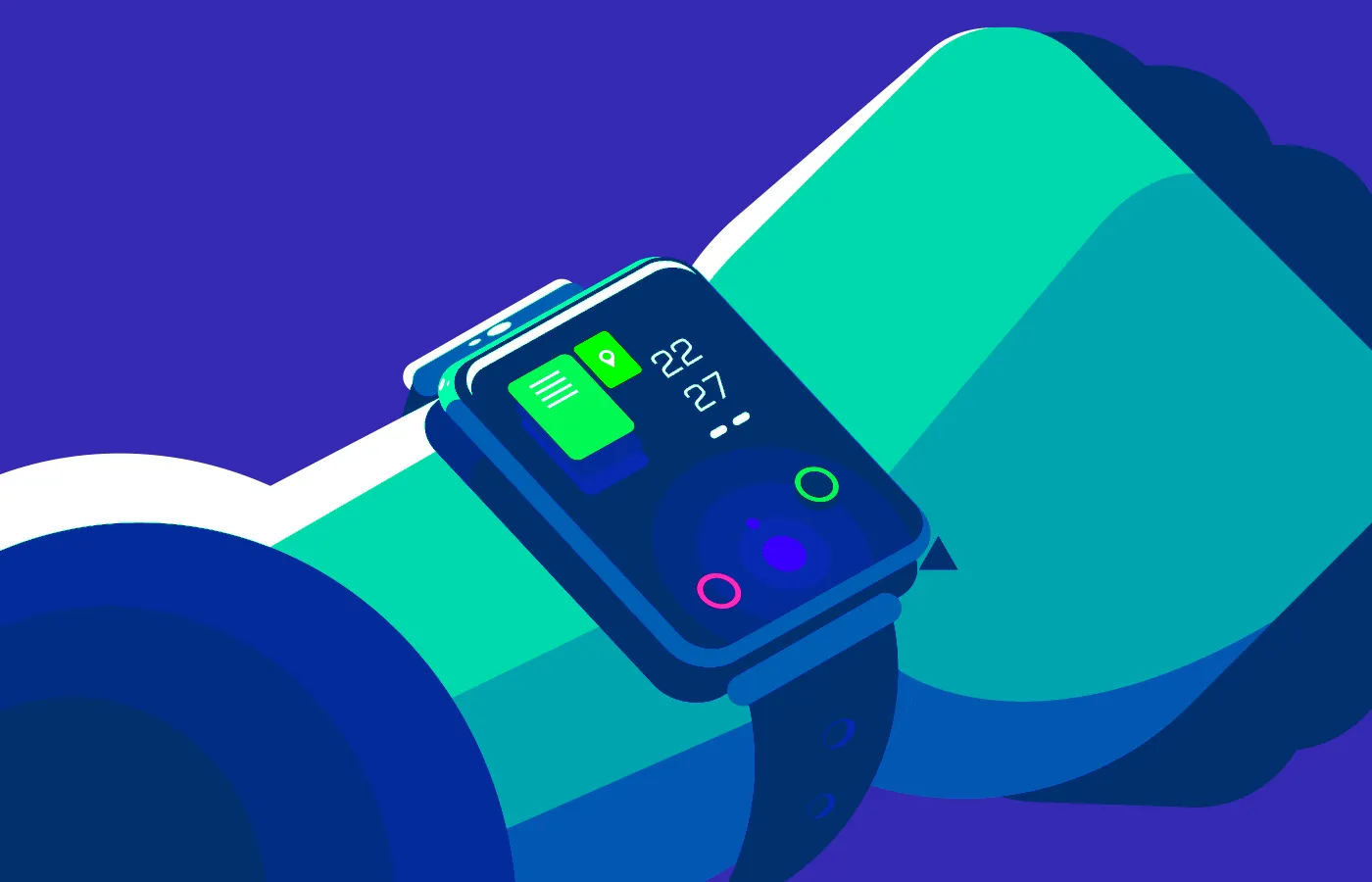blog
How Wearables Can Reshape Enterprise Mobility Paradigms
By Mohan S Enterprise Mobility Digital transformation November 17, 2023

Wearables have become a transformative force in the world of enterprise mobility, bridging the gap between digital transformation and application. These intelligent tools, like smartwatches and glasses with augmented reality, have ushered in a new era of productivity and connectivity in business.
Examples and Use-Cases of Wearables in Enterprises
Wearable technology has established itself across numerous industries, providing creative ways to boost efficiency and productivity. These examples highlight the adaptability of wearables in the workplace and highlight the potential future of wearables in enterprises to improve productivity overall, process efficiency, and safety.
1. Smartwatches: These wrist-worn gadgets, like the Apple Watch and Samsung Galaxy Watch, let professionals access their emails, manage their calendars, and receive notifications while they're on the go. They're especially useful for keeping in touch and organized while traveling and attending meetings.
2. Augmented Reality (AR) Glasses: Augmented Reality glasses like Microsoft HoloLens and Google Glass can be found in manufacturing and field service. They increase accuracy and decrease errors by giving workers access to real-time data overlays, instructional videos, and remote assistance.
3. Fitness Trackers: Fitness trackers from Fitbit and Garmin are examples of wearables that are not just for personal use. They provide information on physical activity, sleep habits, and general health, which can help corporate wellness programs. Organizations use them to encourage employee wellness.
4. Healthcare Wearables: With the ability to track vital signs, remind users to take their medications, and identify irregularities, devices like the Apple Watch and other medical-grade wearables are revolutionizing healthcare.
5. Industrial Smart Helmets: These helmets, like the DAQRI Smart Helmet, are made for construction and industrial workers and use augmented reality technology to show important information, safety alerts, and blueprints right in the user's line of sight.
6. Ring Scanners: In warehouse and logistics operations, these small, finger-worn devices, like the Zebra RS6000, are preferred. They make it possible to scan barcodes without using your hands, which boosts inventory management accuracy and efficiency.
Applications of wearables in enterprises
Wearables have a wide range of business applications that improve productivity, security, and overall operations. These applications demonstrate the extensive advantages of wearables for businesses, from enhancing customer service and employee wellbeing to enhancing productivity and safety. A few important applications are:
1. Field Service and Maintenance: In order to improve diagnostic and repair procedures, technicians and field service personnel use wearables to access manuals, schematics, and real-time data through AR glasses. Downtime is decreased, and customer service is improved.
2. Logistics and Warehousing: Picking, packing, and shipping processes are made easier by wearable technology like smart glasses and ring scanners. Scannable barcodes, order details, and navigation are available to employees, improving accuracy and productivity.
3. Health and Safety: Wearable sensors and communication devices are used to monitor vital signs and share crucial data in real-time in high-risk industries like firefighting. This improves safety and makes it possible to react quickly to emergencies. For instance, Australian firefighters use wearables to increase situational awareness and safety.
4. Manufacturing: Workers may receive real-time data on machine performance, quality assurance, and safety procedures from wearables. AR glasses make it easier for assembly line workers to visualize instructions and spot flaws.
5. Employee Wellness: Fitness trackers are widely used by businesses to promote employee wellness and health initiatives. These tools track employees' physical activity, sleep patterns, and stress levels in an effort to promote a healthier technology-enabled workplace.
6. Retail: Wearables assist with inventory control, price adjustments, and customer service in the retail industry. Employees can quickly check product specifications and inventory levels, increasing customer satisfaction.
7. Healthcare: Wearables help with medication adherence and remote patient monitoring in the healthcare industry. Better patient outcomes result from the ability for doctors and nurses to track patient data and receive alerts.
8. Training and Skill Development: Employee training makes use of augmented reality glasses, which facilitate hands-on learning and shorten the learning curve for challenging tasks.
9. Quality Control and Inspections: Wearables are used in quality control and inspection procedures in sectors like the production of automobiles. They aid in finding flaws and guarantee product quality.
Benefits of Wearables in Enterprises:
The use of wearables in the workplace has brought about a wide range of benefits that support increased productivity and efficiency. Wearables have many advantages for businesses, including improved productivity and a safer, healthier workplace.
Here are some major advantages:
Increased Efficiency: Employees no longer need to switch between devices or consult paper manuals because wearables provide real-time access to crucial information and tools. Tasks become more efficient as a result, and decision-making moves more quickly.
Enhanced Productivity: Wearables enable employees to complete tasks more quickly and accurately by giving them instant access to data, instructions, and notifications. As a result, productivity increases in a variety of industries, including manufacturing and healthcare.
Improved Safety: Workplace safety is greatly aided by wearable technology. For instance, they can keep an eye on vital signs in dangerous environments and send out prompt alerts in an emergency. This improves the wellbeing of workers in dangerous professions.
Training and Skill Development: Immersive training is made possible by wearables with augmented reality capabilities. Employees can learn new skills more quickly and accurately, which lowers errors and boosts job proficiency.
Health and Wellness: Wearable fitness trackers are useful for employee wellness programs because they promote a healthier lifestyle by monitoring physical activity and giving insights into individual health. A happier, more effective workforce results from this.
Inventory Management: Wearables make inventory management easier in logistics and warehousing. They make it possible to scan barcodes seamlessly, which lowers errors, improves stock levels, and ultimately conserves time and resources.
Improved Customer Service: Employees who interact with customers can now instantly access customer data, product details, and inventory levels thanks to wearable technology. This results in improved customer satisfaction and better customer service.
Remote Monitoring: Wearables enable remote patient monitoring in industries like healthcare, which eliminates the need for frequent in-person appointments. This improves patient care while also bringing down the price of healthcare.
Data Analytics: Organizations can use the valuable data that wearables produce for performance analytics and process improvement. Greater efficiency and cost savings are the results of these data-driven decisions.
Customization and Adaptability: Wearables can be customized to meet the unique requirements of various industries and job roles, providing flexibility and adaptability in a variety of office settings.
Challenges for Implementation
Wearables have many benefits for the workplace, but implementing them successfully can present some difficulties. Wearables in the workplace can be successfully implemented if these issues are addressed with careful planning, employee involvement, and a well-thought-out strategy.
Here are some common road bumps and potential solutions:
1. Data Security Concerns
Challenge: Wearables can collect sensitive data, raising concerns about data security and privacy.
Solution: Employ robust encryption and access controls to protect data. Develop clear policies for data usage and storage.
2. Integration with Existing Systems
Challenge: Integrating wearables into existing IT infrastructure can be complex and costly.
Solution: Plan for seamless integration by working closely with IT experts and selecting wearables that offer compatibility with current systems.
3. Employee Resistance
Challenge: Some employees may be hesitant to adopt new technology.
Solution: Provide comprehensive training and emphasize the benefits of wearables to alleviate resistance. Involve employees in the selection process to ensure a good fit.
4. Costs and ROI Concerns
Challenge: The initial investment in wearables can be substantial, leading to concerns about return on investment (ROI).
Solution: Calculate the potential cost savings and efficiency improvements that wearables can bring. Develop a clear ROI strategy and monitor its progress.
5. Compliance and Regulatory Issues
Challenge: Various industries have specific regulations regarding data collection and privacy.
Solution: Ensure that wearables and related processes comply with industry regulations. Consult with legal experts to navigate complex regulatory landscapes.
6. Battery Life and Maintenance
Challenge: Wearable devices often have limited battery life, and maintenance can be a concern.
Solution: Select wearables with adequate battery life for the intended use. Establish maintenance routines to address issues promptly.
7. Scalability and Customization
Challenge: As businesses grow and evolve, the scalability and customization of wearables may become problematic.
Solution: Choose scalable wearable solutions and work with providers who can adapt to changing business needs.
8. Data Overload
Challenge: Wearables can generate a substantial amount of data, potentially overwhelming employees.
Solution: Implement data analytics tools to process and filter data, providing actionable insights rather than inundating employees with raw information.
9. Interoperability
Challenge: Different wearables may not be compatible with each other or with existing systems.
Solution: Prioritize interoperability when selecting wearables and ensure that they can work together seamlessly.
10. Cultural Shift
Challenge: Implementing wearables may require a cultural shift in the organization.
Solution: Foster a culture of innovation and continuous improvement, encouraging employees to embrace change.
Conclusion
The integration of wearables in the workplace has the potential to revolutionize the way businesses run, providing an array of advantages ranging from increased productivity and improved safety to improved employee well-being. These gadgets, such as smartwatches, augmented reality glasses, and fitness trackers, have demonstrated their adaptability across numerous industries, from healthcare to logistics, bringing about positive changes that spread throughout organizations.
Even though wearables have clear benefits, implementing them can be difficult due to issues with data security, system integration, employee resistance, and compliance. These difficulties can be overcome, though, with careful planning, thorough training, and an emphasis on data privacy.
Wearables are poised to become more and more important as technology advances in the future of the workplace. They have the potential to build more sociable, effective, and adaptable workplaces where workers are given the tools they need to excel. Organizations must be vigilant in addressing issues and seizing opportunities in order to fully utilize wearable technology. By doing this, they can usher in a new era of innovation and productivity at work.




